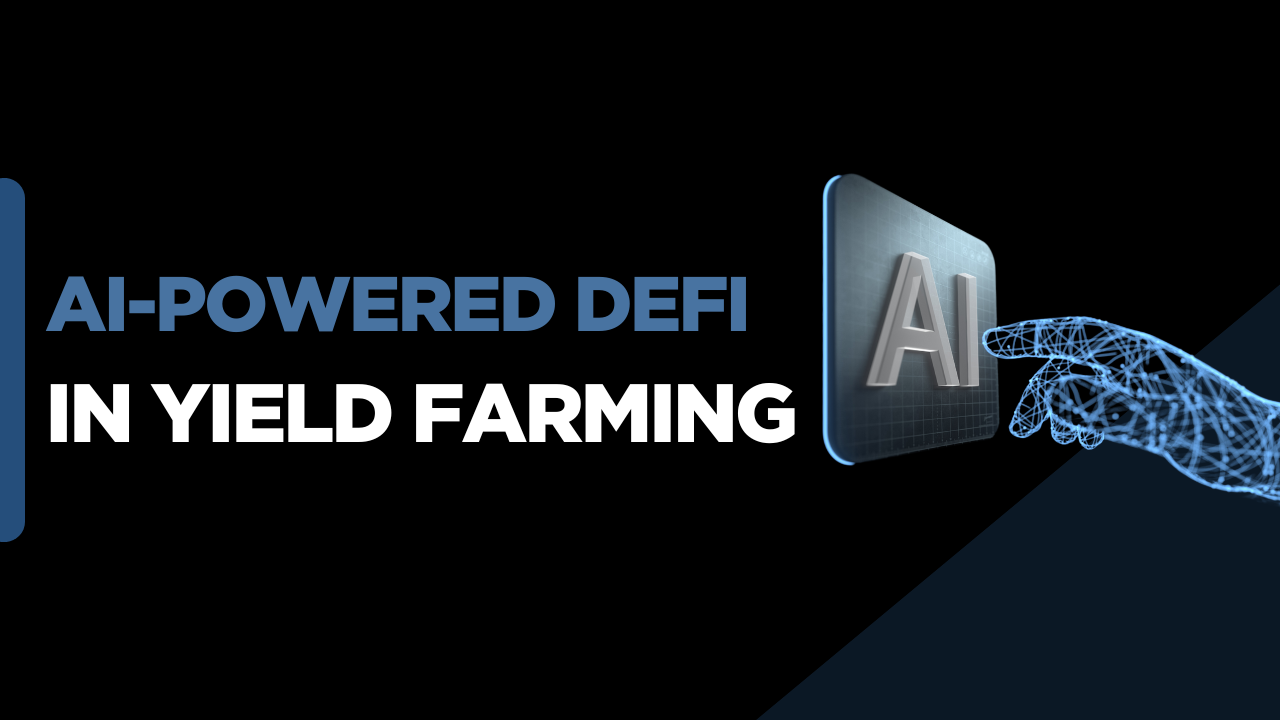AI-Powered DeFi in Yield Farming

The intersection of artificial intelligence (AI) and decentralized finance (DeFi) is reshaping financial landscapes, particularly in yield farming and risk management. Yield farming, a strategy where users provide liquidity to DeFi protocols to earn rewards, has grown in popularity but faces challenges like impermanent loss, market volatility, and smart contract vulnerabilities. AI’s ability to process vast datasets and predict outcomes is proving transformative, offering tools to optimize strategies and mitigate risks. This survey note explores how AI is integrated into DeFi, focusing on key projects and their implications for traders in competitive markets.
Understanding Yield Farming and Its Challenges
Yield farming involves lending or staking cryptocurrencies in liquidity pools on DeFi platforms to earn rewards, typically in additional tokens. For instance, platforms like Uniswap and PancakeSwap allow users to deposit assets, earning yields based on trading fees or incentives. However, this practice is not without risks:
- Impermanent Loss: Impermanent loss occurs when the price of assets in a liquidity pool fluctuates, causing a difference between the value of the assets if they were simply held versus their value within the pool. This phenomenon is particularly relevant in decentralized finance (DeFi), where liquidity providers deposit assets into pools to facilitate trading. The Automated Market Maker (AMM) algorithm ensures that the pool remains balanced, but when asset prices diverge significantly, liquidity providers may experience losses compared to holding the assets outright. Here are some common risks associated with it:
- Extreme Price Divergence: If one asset in the pair surges or crashes in value relative to the other, the liquidity provider may suffer a loss compared to simply holding the assets.
- Low Trading Volume: Pools with low trading activity may see higher exposure to impermanent loss, as fees earned may not be enough to offset the losses.
- Protocol Design Weaknesses: Certain Automated Market Maker (AMM) models may magnify losses, especially those that lack dynamic fee structures to account for volatility.
- Market Volatility: Market volatility refers to the rapid and unpredictable price swings that can impact investment returns. In 2025’s dynamic financial landscape, volatility is heightened due to factors such as macroeconomic shifts, regulatory changes, and technological advancements. Traders often experience these common risks:
- Flash Crashes: Sudden, sharp drops in price can wipe out leveraged positions or trigger stop-loss orders, leading to unexpected losses.
- Liquidation Risks: Traders using leverage may face forced liquidation when price swings exceed their collateral levels.
- Liquidity Shortages: In extreme market conditions, assets may become difficult to trade, preventing users from exiting positions at favorable prices.
- Smart Contract Risks: Smart contracts are self-executing agreements written in code and deployed on blockchain networks. While they enhance efficiency and transparency, they also introduce security vulnerabilities. Common risks include:
- Reentrancy attacks, where an attacker repeatedly calls a function to drain funds.
- Integer overflow/underflow, which can manipulate transaction values.
- Malicious insiders may exploit contract weaknesses. To mitigate these risks, developers must conduct rigorous audits, implement secure coding practices, and use formal verification methods to ensure contract integrity.
These challenges highlight the need for advanced tools, and AI is emerging as a solution by enhancing data analysis, risk assessment, and automation.
The Role of AI in DeFi
AI’s integration into DeFi leverages machine learning to process and analyze vast financial datasets, identifying patterns imperceptible to human analysts. According to OSL Academy, AI enhances:
- Data Analysis: Processes large datasets quickly, using historical data for future strategies, improving yield forecasting with predictive analytics.
- Risk Management: Assesses market volatility, uses predictive models to forecast risks, and adjusts strategies in real-time, enhancing security through continuous monitoring.
- User Experience: Implements chatbots for instant support, personalizes recommendations, and simplifies interfaces, increasing accessibility for broader participation.
- Automated Trading: Executes trades based on data, minimizes emotional biases, and adapts strategies to market changes, freeing up investor time.
For example, AI can predict market trends, helping users avoid losses during volatile periods, and automate trades to maximize returns, as seen in platforms like Fetch.ai - https://fetch.ai/blog/agent-based-trading-tools-for-decentralized-exchanges.
Case Studies of AI in DeFi
Several projects exemplify AI’s transformative role in DeFi, each offering unique solutions for yield farming and risk management:
Numerai
Numerai, founded in 2015, is a hedge fund using AI to make investment decisions by crowdsourcing machine learning models from global data scientists, as detailed on Numerai’s official site. In 2018, it introduced Erasure, a DeFi marketplace for finance-related data, enabling decentralized application building for buying and selling predictions on the Ethereum blockchain, as noted in Cointelegraph. This integration allows Numerai to optimize yield farming by leveraging predictive analytics and risk assessment, though specific TVL growth figures like the mentioned $10M were not found in recent data, suggesting it may be a future projection or typo.
Fetch.ai
Fetch.ai, based in Cambridge, UK, develops AI tools for decentralized exchanges (DEXs), focusing on agent-based trading. As per VentureBeat, it unveiled AI-powered trading tools in 2023, using intelligent agents to optimize DeFi trade execution and enhance user experience. These agents execute trades based on user-defined parameters, addressing inefficiencies and high fees, as seen in its integration with Uniswap V2 and PancakeSwap, reported by CoinDesk. This automation is crucial for yield farming, ensuring optimal outcomes and reducing manual intervention.
IAESIR
IAESIR, an AI-powered hedge fund, automates DeFi investing, focusing on yield optimization and risk management, as described on IAESIR’s blog. It offers AI-driven features like real-time identification of profitable yield farming pools, impermanent loss protection by adjusting strategies, and automated reinvestment for exponential growth. With institutional-grade security via Binance Custody and regulatory compliance with VARA and SEC, IAESIR makes yield farming accessible and profitable, reporting a 66% annual return in 2024 with millions in assets under management (AUM).
Benefits and Implications for Traders
The integration of AI into DeFi offers significant benefits for traders:
- Improved Returns: AI optimizes yield farming strategies by analyzing real-time data and predicting market trends, potentially increasing annual percentage yields (APYs) to 15-50%, as suggested by itsbryanblake.com.
- Reduced Risks: AI tools predict volatility and adjust strategies, mitigating risks like impermanent loss, as seen in IAESIR’s approach, and enhance security through continuous monitoring, per the article How AI is Shaping the Future of Yield Farming in DeFi on OSL Academy.
- Increased Accessibility: Automation simplifies complex processes, making DeFi more user-friendly for retail investors, with AI chatbots and personalized recommendations, as noted in Fetch.ai’s platform.
- Enhance Efficiency: AI eliminates the need for manual monitoring, allowing traders to focus on strategy rather than execution.
- Sentiment Analysis: AI scans news, social media, and financial reports to gauge market sentiment, providing traders with a broader perspective.
For traders in competitive markets, AI provides a significant edge, enabling higher returns with lower risks, though success depends on choosing reputable platforms and managing risks, as highlighted by CoinBureau.
Conclusion
AI is transforming yield farming and risk management in DeFi, with projects like Numerai, Fetch.ai, and IAESIR leading the way. By optimizing strategies, predicting risks, and automating processes, AI enhances returns and accessibility, though regulatory challenges remain. As we move through 2025, the integration of AI and DeFi will continue to evolve, offering traders powerful tools to navigate competitive markets and shape the future of finance.
You can keep in touch with MITOSIS by following:
WEBSITE || X (Formerly Twitter) || DISCORD|| DOCS


Comments ()